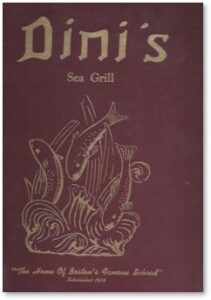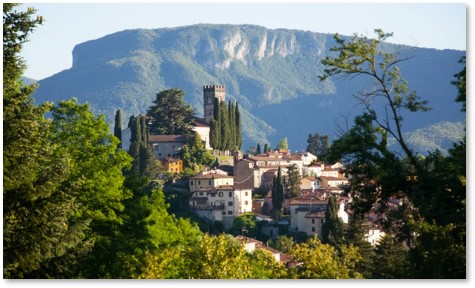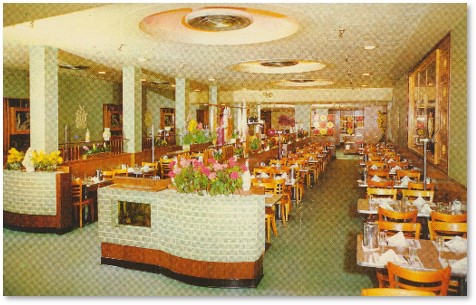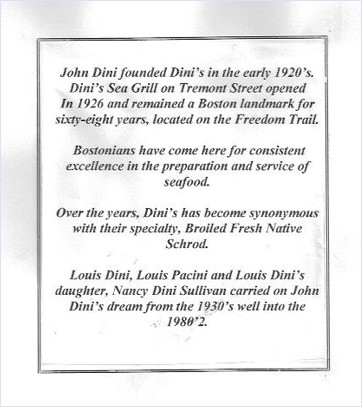I never know when I will hear from people who have read one of my blog posts but I love to read those emails or comments when they appear. This week, I heard from Joseph Dini, son of the man who owned and ran Dini’s Sea Grills.
Dini’s Sea Grill on Tremont Street
Mr. Dini was responding to my blog post on Pieroni’s Sea Grill that appeared in August of 2018. I remember Dini’s Sea Grill quite well, although I think I ate there only once, on a date. (I had the scallops.)
If you ever walked Down Tremont Street sometime before 1990, you can probably envisage that colorful marquee quiet well. What comes to my mind immediately is the huge lobster they used to have in the front window.
Dini’s was one of the many seafood restaurants that used to be found all over the city, Seafood was cheap back then and these establishments served it fresh, prepared simply but well, and at reasonable price points. Most of them are gone now.
The information in this post on the restaurant and the Dini family history came from Joseph Dini.
From Tuscany to Scotland
Joseph Dini’s father, Giovanni (John) Dini was born in Barga, Italy in 1895, five years after Giuseppe Pieroni, left the same town in Tuscany. Mr. Dini, the son of tenant farmers, was only 15 years old when he emigrated to Glasgow, Scotland, along with other young men from the same area.
In Barga, Giovanni probably worked for Pietro Bertacchi, an absentee landlord who took his rents in 50 percent of everything produced. This made it very difficult for the sharecroppers known as mezzadri to make a living.
From Scotland to Boston
After his arrival in Glasgow, Mr. Dini indentured himself to the owner of a fish-and-chips business on the docks. By 1914 he had established residence in Scotland and was able to migrate from Glasgow to Boston.
Once here, he went to work at the Pieroni’s Sea Grill on Boylston Street. Hard-working, as are many immigrants, he had become a minor shareholder by the early 1920s.
Giovanni Dini opened the first Dini’s Sea Grille, also on Boylston Street, in 1926. On the docks in Glasgow, he learned the people like to eat quickly and he wanted to serve quick lunches. He discovered that a fish called schrod—the tail end of the hotel filet of cod—cooked up fast. Thus, he served schrod and the rest is history.
The Barga Connection
Barga lies northwest of Florence in Tuscany and dates back to at least 900 AD. The connection with Glasgow began in the late nineteenth century, when Barga’s silk industry collapsed and farmers were exploited by large landowners such as Mr. Bertacchi.
But why Glasgow? What drew ambitious young men from sunny Tuscany to dour and rainy Scotland? The connection involves ice cream and the city of London.
Ice Cream in London
An immigrant named Carlo Gatti moved to London and began selling ice cream there. He imported help from back home in Italy, one of whom was a man named Giulini, from Barga. Mr. Giulini later moved to Glasgow, where he set up three cafes and many street-corner ice cream carts.
To operate his restaurants and carts, Mr. Giulini also imported help although those workers came mostly from south of Rome. Once established, the new immigrants founded their own cafes, fish-and-chip shops, and restaurants. By 1905, Glasgow held over 300 ice cream shops, mostly run by Italian families. A man named Primo Marchi owned fish-and-chip shops and brought in workers from Barga. He may have been the man who hired Giovanni Dini.
Thus, there were Italians in Glasgow because immigrants often help newcomers from the Old Country. Your countrymen share values, a language, a religion, and a work ethic. They are, therefore, the people you know best, with whom you can speak easily, and who can be most trusted.
The Barga-Glasgow Connection Continues
A connection between Barga and Glasgow still exists, however, with people moving back and forth to work and to enjoy holidays. Every summer (except this one), many Glaswegians descend on Barga for a vacation and it’s known as the most Scottish town in Italy. It’s probably the only town in Italy where you can hear Scottish accents around every corner.
So, now we have two connections: the one between Barga and Boston, the second between Barga and Glasgow. It seems an unlikely triangle but history often works in unusual ways.
The Last Dini’s Sea Grill
Giovanni’s brother, Louis, operated the last Dini’s Sea Grill at 94 Tremont Street, right on the Freedom Trail. The location proved to be perfect for denizens of the Massachusetts State House to descend on the restaurant for a fast lunch. It once made front-page news when Gov. Edward King had $1,200 worth of lobster and crabmeat sandwiches delivered to his office from Dini’s. The Tremont Street Dini’s was a Boston institution for 64 years until its closing in 1990,
Gone but not forgotten. Boston.com listed Dini’s Sea Grill as one of the now-closed restaurants that Bostonians miss the most. In addition to Dini’s and Pieroni’s, we have lost Anthony’s Pier 4, Jimmy’s Harborside, and the No-Name on the Fish Pier. Now if we want seafood in Boston, we can go to one of the Legal Seafoods outlets, where the fish is no fancier but where they prices are high and raised seemingly every month.
My thanks to Joseph Dini for offering his information and for letting me know about the Barga-Glasgow Connection.






thanks – nice Blog- However, you got me as the grandson of John Dini- I am his son. No big deal
I fixed it. Thanks for the correction.